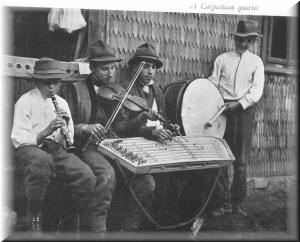Previous
UNDER
THE CARPATHIANS
HOME OF A FORGOTTEN PEOPLE
Wine and Tobacco
Next
|
Previous |
UNDER THE CARPATHIANS HOME OF A FORGOTTEN PEOPLE
Wine and Tobacco |
Next
|
 The
sunny foothills of the main Carpathian range and the rich soil of the lowlands
are well suited to the cultivation of vines and tobacco plants . Small wonder
the production of wine and tobacco has been an integral part of the country’s
economy for centuries. While Carpatho-Ukraine was incorporated in Hungary ,
which abounded in both of these, their cultivation in the northern province
served mainly to satisfy local requirements. The situation changed under the
Czechoslovak administration, which strove to develop both industries in the
interest of the producers and of a new set of customers as well as the inland
revenue. In Czechoslovakia the tobacco industry was a State monopoly, and the
authorities did their utmost to enforce the corresponding legal provisions.
Many of the growers, accustomed as they had been to less strict control,
resisted these monopolist tendencies and resorted to many ingenious tricks in
their attempts to outwit the authorities. This applied particularly to the
cultivation of tobacco which the small growers planted in occasional patches
in fields where they grew potatoes, wheat, poppy-seed and even maize, in order
to hide the illegal crop from vigilant officials. The struggle went on year
after year, and the authorities never quite succeeded in bringing the most
recalcitrant offenders to heel, though their efforts to develop these two
industries were on the whole successful.
The
sunny foothills of the main Carpathian range and the rich soil of the lowlands
are well suited to the cultivation of vines and tobacco plants . Small wonder
the production of wine and tobacco has been an integral part of the country’s
economy for centuries. While Carpatho-Ukraine was incorporated in Hungary ,
which abounded in both of these, their cultivation in the northern province
served mainly to satisfy local requirements. The situation changed under the
Czechoslovak administration, which strove to develop both industries in the
interest of the producers and of a new set of customers as well as the inland
revenue. In Czechoslovakia the tobacco industry was a State monopoly, and the
authorities did their utmost to enforce the corresponding legal provisions.
Many of the growers, accustomed as they had been to less strict control,
resisted these monopolist tendencies and resorted to many ingenious tricks in
their attempts to outwit the authorities. This applied particularly to the
cultivation of tobacco which the small growers planted in occasional patches
in fields where they grew potatoes, wheat, poppy-seed and even maize, in order
to hide the illegal crop from vigilant officials. The struggle went on year
after year, and the authorities never quite succeeded in bringing the most
recalcitrant offenders to heel, though their efforts to develop these two
industries were on the whole successful.
The chief centre of the wine and tobacco trade was Berehovo, which had some 20,000 inhabitants and was the third largest town of the province at the time when it was part of Czechoslovakia. It was situated close to the then Hungarian frontier and its population consisted largely of Magyars ; there were considerable numbers of Jews, but only a sprinkling of Ukrainians. The place had the usual haphazard mixture of town and country features and its attractions were few. But many of its citizens lived in one- or two-storied houses built in the over-decorated style of the last century and wreck fairly prosperous, for trade was thriving and life was gay.
More attractive was the little town called Sevlyus, lying in the plain to the south of a steep hill covered with terraced vineyards. One of the town’s few points of interest was a white-washed Gothic church -a rarity in the lowlands, for practically every Gothic. building in south-eastern Europe was destroyed by the Turks during their long occupation of the Danube basin. The population of Scvlyus was largely Ukrainian. In spite of its small size it played its part in the economic life of the country The Czechs built an imposing six-storied plant there in which tobacco was dried and treated. Apart from tobacco and wine, Sevlyus had a few of those minor industries which could be found in practically every town of the province ; they included a furniture factory and a couple of small timber mills and brick-kilns.
In October, the townships of the vine-growing districts used to resound with revelry. It was vintage time. In garishly decorated carts provided by the owners of the larger vineyards the peasants drove to the nearest township to celebrate. First they flocked to the church to give thanks, and then they settled down to enjoy themselves. In the market square large cauldrons were filled with meat and hung over open fires, and soon every one could eat his fill of succulent paprika goulash. The heady new wine and the brisk strains of the music spurred on the revelers to exuberant merry-making to compensate for all the hard work of the season which was just ended.
[A Carpathian Quartet]